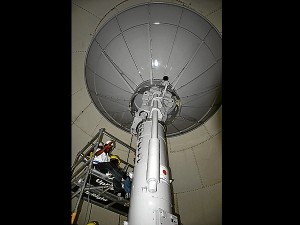Doppler radars using new tech ready by March

RADAR DOME. Weathermen familiarize themselves with the Doppler radar’s antenna under the guidance of Japanese technicians. FERNAN GIANAN/INQUIRER SOUTHERN LUZON
VIRAC, Catanduanes—The first of three Doppler radars being built in the Philippines using new Japanese technology is set to operate in March, supposedly the first such facility in the world to use solid state technology.
The Solid-State Meteorological Radar System (SSMRS) technology, developed by Japan Radio Co. (JRC), will make for a more accurate system of warning against potential calamities, Assistant Science Secretary Robert Dizon said.
Dizon came here last week to inspect the facility in the town of Buenavista.
The new S-band system uses integrated chips to transmit sound waves as far as 480 kilometers away to determine wind velocity, rainfall intensity and speed, volume of rainfall and area coverage. This would make it possible for the Philippine Atmospheric, Geophysical and Astronomical Services Administration (Pagasa) to issue forecasts with a high degree of accuracy, depending on the interpretation of the radar images, Mark Lazaro of JRC said.
“This pioneer radar system has a lower power consumption and will last for as long as 15 years,” he said. In comparision, the existing Doppler technology uses US-made coaxial magnetrons costing P3 million each which would have to be replaced every three or four years.
It also has an all-digital instrumentation so anybody who knows computers will be able to operate it, with the entire system relatively easy to maintain, Lazaro stressed.
The new radar system technology, he added, would be ultimately brought to other countries by the Japanese government through its grants-in-aid program.
Common solid state devices include transistors, microprocessor chips, integrated circuit (IC), light-emitting diode (LED) and DRAM (dynamic random access memory) hard drives used in netbooks and similar computers.
The facility, built for P560 million by Shimizu Construction and FF Cruz Construction, will complement two other SSMRS Doppler radar systems being completed by the same Japanese-Filipino consortium in Guiuan, Samar province, and Aparri, Cagayan province, according to Dizon.
The facilities are funded by a loan package from the Japan International Cooperation Agency.
Lazaro said he expected weathermen from other parts of the world to take a look at the Buenavista facility, which is expected to help Pagasa give more accurate weather forecasts.
450 kph winds
The three new Doppler radars should help the seven existing US-made Doppler radar systems patch “holes” in weather radar coverage across the Philippines, Dizon said.
The seven US-made Doppler radars are in Baguio City, Baler (Aurora province), Subic (Zambales province), Hinatuan (Surigao del Sur province), Tagaytay City, Mactan City (Cebu province) and Tampakan (South Cotabato province). Three more are to be installed in Antique province, the Zamboanga Peninsula and Palawan province.
Pagasa-Virac chief meteorological officer Eufronio Garcia said the 44-meter-tall radar tower built on top of a mountain in Buenavista is safe from landslides, being anchored to the bedrock by a concrete mat foundation sitting on concrete piles driven to an average depth of 24 m.
The tower, made of thin fiberglass plates bolted together, can withstand winds of up to 450 kilometers per hour, Lazaro said. He added that he was now working with Japanese technicians in testing the system, the first to be built in the world.
Power delivery
The Doppler radar facility has four major components—a radar system, a data display system, a satellite communications system and a Very Small Aperture Terminal (VSAT), all enclosed in the radar tower.
Pagasa weathermen from Virac and other radar sites underwent training on how to use and maintain the equipment. Training was also conducted at Pagasa Manila for personnel who will interpret the images to be sent via satellite by the Buenavista radar station, Dizon said.
Pagasa is also hiring two more weathermen to add to its existing seven personnel in Catanduanes to man both the Buenavista facility and the synoptic station in Barangay San Isidro, Virac.
A more serious issue that could affect the radar’s operation would be the chronically inefficient power service delivered by First Catanduanes Electric Cooperative.
Voltage fluctuations
The three-phase electricity supplied by the cooperative suffers from voltage fluctuations that could damage the sensitive equipment, according to a Pagasa staffer who requested anonymity as he has no authority to speak on the matter.
While the new Doppler radar is backed up by two diesel generators that kick in 15 seconds after a power outage and can be run in 24-hour turns, the fuel cost can be considerable as the generators consume as many as 15 liters per hour, the source added.
Pagasa would have to allocate adequate funds for the generators’ fuel requirement if the locally supplied power is deemed inadequate.
Operates continuously
During the operation of the old radar, lack of funds forced Pagasa to run the radar for only two weather observations of one hour each, at 8 a.m. and 2 p.m., and for a full 24 hours only when a typhoon threatens the country.
This scheme would not work with the new Doppler radar, the source said, as it is designed to operate continuously, according to JRC technicians.
Pagasa officials said they would invite President Aquino to lead the inauguration of the Doppler radar, along with governors and congressmen from the Bicol region, the usual target of typhoons.
Beacon for fishermen
In the past two decades, three of the country’s worst typhoons slammed into Catanduanes, the latest being “Reming” in 2006 which destroyed 15,000 homes in three towns before crossing into Albay province, where it caused massive flooding that killed hundreds of residents.
Already, fishermen from the coastal towns of Bato, Baras and Gigmoto in this island province have started thanking the national government for the new radar facility, whose four red pilot lights on the radome are now serving as beacons guiding them home at night.